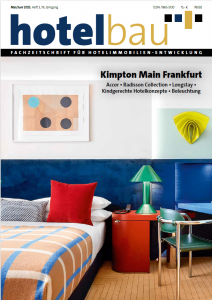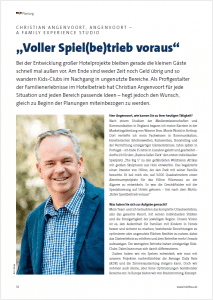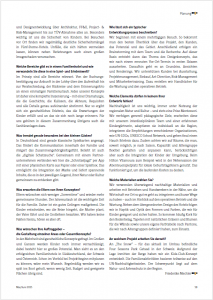Child-friendly Hotel Concepts
An interview with Christian Angenvoort about child-friendly hotel concepts.
The following interview by Friederike Mechler appeared in the Mai/Juni 2025 edition of the trade journal hotelbau and was reproduced here, translated from German into English, with kind permission



During the development of large hotel projects, the smallest guests are often quickly overlooked. In the end, neither time nor money is left, and kids’ clubs often end up in unused areas as an afterthought. As a professional designer of family experiences in the hotel industry, Christian Angenvoort has suitable ideas for every situation and every space – but he would really like to be involved right from the start of the planning process.
Mr. Angenvoort, how did you arrive at your current profession?
After studying Media and Communication in England, I began my career in the marketing department of Warner Bros. Movie World in Bottrop. There, I deepened my expertise in communication, artistic themed environments, set construction, storytelling, and creating unique guest experiences.
Years later in Portugal – I lived and worked in Lisbon for 25 years – I had the opportunity to design the first custom playground for the Badoca Safari Park: “The Big 5”, dedicated to Africa’s endangered wildlife, featuring large wooden sculptures. An investor from Hilton, who visited the park with his family, was impressed and he invited me to design a 3,000-square-meter adventure playground for the Hilton Vilamoura in the Algarve.
And that’s how the business idea was born – specializing in hotels, under the motto „Voller Spiel(be)trieb voraus!“, a play on words in German which in English can be translated to “Full speed ahead with play(operations)!”
What’s your main goal or purpose in your work?
My team and I look at the entire vacation experience — the whole resort — with its individual strengths and the unique character of each region. Our vision is to make hotel stays better and safer for families with children, to optimize existing facilities, and to make more flexible use of underutilized spaces — all while enhancing the guest experience and helping operators identify new revenue opportunities.
Very few properties offer truly unique kids’ clubs, even though this can be a key differentiator. We’ve also developed a system that clearly demonstrates how our projects can increase the Average Daily Rate (ADR) and room occupancy.
But we also carry out small yet meaningful improvements to existing areas. Across Europe, we offer everything from brainstorming, concept and design development, to architecture, FF&E, project and risk management, all the way through to TÜV certification.
Child safety is especially important to us. During on-site visits, we regularly identify serious safety issues in five-star hotels. Accidents that could have been avoided can not only lead to injuries but also cause significant damage to a brand’s reputation.
What areas are typically found in a family hotel, and how do you transform them into playful, engaging environments for guests?
In principle, every area is relevant – from the booking confirmation to arrival in the lobby, the stay itself, the farewell, the journey home, and the souvenir photo from a memorable family vacation.
That’s why each of our concepts is a complete staging — with a dramaturgy that aligns the story, scenery, characters, props, and every detail in harmony.
Only in this way can a holistic experience emerge — one that meets children’s expectations and stays in their memories for a long time.
And by the way, for us, that includes the restrooms too.
What are the latest trends among young guests?
In Germany, classic playing cards are currently very popular. They encourage communication within the family and strengthen the sense of togetherness.
Another favorite is the “digital treasure hunt.” In collaboration with a partner company, we combine a scavenger hunt app with a physical paper map or a game box. This allows for brand integration and provides exciting content to explore together — whether it’s the local area, nature, or culture.
What are parents looking for in your concepts?
Parents are looking for less screen time and more quality time together.
The annual vacation is the most important time for the family, so making it a success is crucial. The children decide where to go, the mother takes care of the planning, the father drives, and the grandparents pay. We don’t have hard data on this — but we hear it often.
What do your clients typically request — the design of individual areas or complete concepts?
In most cases, holistic concepts are in demand. Overall, children are still often overlooked — even though there’s so much potential in this area. You can see it in the success of family hotels in southern Germany, Switzerland, and Austria.
My wish is to be involved right from the start of a project. Too often, we’re brought in too late — when time, budget, and suitable space are already running low.
How would you describe a typical development process?
We start with a multi-day site visit. This gives us the best possible understanding of the project, the client, the potential, and the location. After that, we hold a brainstorming session with the team and conduct research. Based on that, we develop the theme for the design concept, which we begin to visualize through initial sketches following another on-site visit. From there, we move on to floor plans, views, and renderings.
We support our clients with furnishings, project management, procurement, art direction, risk management, and staff training. We also create manuals for maintenance and daily operations.
What elements are never missing from your concepts?
Sustainability is important to us — always incorporating the local nature and culture, and always with a touch of Montessori.
We always pursue educational goals, which we develop together with our interdisciplinary team and an experienced kindergarten teacher. These goals are adapted to the local region and enriched with input from various organizations, such as the UN Sustainable Development Goals and the UNESCO School Network. And finally, we add a touch of adventure and experience.
We also focus on creating spaces that, wherever possible, can be flexibly adapted depending on the season, capacity, and age group — while also considering the integration of local children from the surrounding area. At Hilton Vilamoura, for example, the adventure playground is used for local birthday parties during the off-season. This works well to help cover ongoing operational costs.
Which materials do you choose?
We primarily use sustainable materials and work with local businesses and craftsmen to support the regional economy as much as possible and to keep supply routes short — which also benefits ongoing operations and maintenance.
In addition to aligning with the hotel’s overall design, we choose textures and colors that we consider safe and suitable for children.
For example, we often use cork flooring, wall coverings made from natural grasses and flowers, and our own custom Pantone color palette, which we’ve developed based on different age groups.
What project are you currently working on?
On “The Snow” – a project for the Four Seasons Park Gstaad in Switzerland, which is currently undergoing renovation.
Given its location in the heart of the mountains, we’ve developed a kids’ club concept where family activities are partly based on the UN Sustainable Development Goals. The focus is on nature and wildlife conservation in the region.
